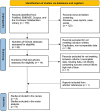Causes and risk factors for same-day discharge failure after total hip and knee arthroplasty: a meta-analysis
- PMID: 38824204
- PMCID: PMC11144238
- DOI: 10.1038/s41598-024-63353-9
Causes and risk factors for same-day discharge failure after total hip and knee arthroplasty: a meta-analysis
Abstract
In recent decades, the trend toward early same-day discharge (SDD) after surgery has dramatically increased. Efforts to develop adequate risk stratification tools to guide decision-making regarding SDD versus prolonged hospitalization after total hip arthroplasty (THA) remain largely incomplete. The purpose of this report is to identify the most frequent causes and risk factors associated with SDD failure in patients undergoing THA and total knee arthroplasty (TKA). A systematic search following PRISMA guidelines of four bibliographic databases was conducted for comparative studies between patients who were successfully discharged on the same day and those who failed. Outcomes of interests were causes and risk factors associated with same-day discharge failure. Odds ratios (OR) were calculated for dichotomous variables, whereas mean differences (MD) were calculated for continuous variables. Meta-analysis was performed using RevMan software. Random effects were used if there was evidence of heterogeneity. Eight studies with 3492 patients were included. The most common cause of SDD failure was orthostatic hypotension, followed by inadequate physical condition, nausea/vomiting, pain, and urinary retention. Female sex was a risk factor for failure (OR 0.77, 95% CI 0.63-0.93), especially in the THA subgroup. ASA score IV (OR 0.33, 95% CI 0.14-0.76) and III (OR 0.72, 95% CI 0.52-0.99) were risk factors, as were having > 2 allergies and smoking patients. General anesthesia increased failure risk (OR 0.58, 95% CI 0.42-0.80), while spinal anesthesia was protective (OR 1.62, 95% CI 1.17-2.24). The direct anterior and posterior approaches showed no significant differences. In conclusion, orthostatic hypotension was the primary cause of SDD failure. Risk factors identified for SDD failure in orthopedic surgery include female sex, ASA III and IV classifications, a higher number of allergies, smoking patients and the use of general anesthesia. These factors can be addressed to enhance SDD outcomes.
Keywords: Failed discharge; Hip arthroplasty; Joint arthroplasty; Knee arthroplasty; Outpatient; Same-day discharge.
© 2024. The Author(s).
Conflict of interest statement
The authors declare no competing interests.
Figures




Similar articles
-
Reasons and Risk Factors for Failed Same-Day Discharge After Total Joint Arthroplasty.J Arthroplasty. 2024 Jun;39(6):1468-1473. doi: 10.1016/j.arth.2023.11.032. Epub 2023 Nov 29. J Arthroplasty. 2024. PMID: 38040065
-
Same-Day Discharge Total Hip and Knee Arthroplasty: Trends, Complications, and Readmission Rates.J Arthroplasty. 2022 Mar;37(3):444-448.e1. doi: 10.1016/j.arth.2021.11.023. Epub 2021 Nov 19. J Arthroplasty. 2022. PMID: 34808278
-
Allergies, Preoperative Narcotic Use, and Increased Age Predict Failed Same-Day Discharge After Joint Replacement.J Arthroplasty. 2021 Jul;36(7S):S168-S172. doi: 10.1016/j.arth.2021.01.015. Epub 2021 Jan 11. J Arthroplasty. 2021. PMID: 33518359
-
Factors associated with hospital stay length, discharge destination, and 30-day readmission rate after primary hip or knee arthroplasty: Retrospective Cohort Study.Orthop Traumatol Surg Res. 2019 Sep;105(5):949-955. doi: 10.1016/j.otsr.2019.04.012. Epub 2019 Jun 15. Orthop Traumatol Surg Res. 2019. PMID: 31208932 Review.
-
Successful same-day discharge in 88% of patients after unicompartmental knee arthroplasty: a systematic review and meta-analysis.Knee Surg Sports Traumatol Arthrosc. 2023 Mar;31(3):946-962. doi: 10.1007/s00167-022-07094-0. Epub 2022 Aug 11. Knee Surg Sports Traumatol Arthrosc. 2023. PMID: 35951077 Free PMC article.
Cited by
-
Efficacy and safety of pregabalin for postoperative pain after total hip and knee arthroplasty: a systematic review and meta-analysis.J Orthop Surg Res. 2025 Mar 11;20(1):261. doi: 10.1186/s13018-025-05675-6. J Orthop Surg Res. 2025. PMID: 40069801 Free PMC article.
-
Effectiveness of an Enhanced Recovery After Surgery (ERAS) Program in Hip Arthroplasty in a Developing Country: A Propensity Score-Matched Study from Vietnam.J Multidiscip Healthc. 2025 May 16;18:2731-2747. doi: 10.2147/JMDH.S521828. eCollection 2025. J Multidiscip Healthc. 2025. PMID: 40395275 Free PMC article.
-
Retrospective comparison of chloroprocaine and mepivacaine in spinal anesthesia for same-day discharge TKA.Knee Surg Relat Res. 2025 Aug 7;37(1):33. doi: 10.1186/s43019-025-00283-4. Knee Surg Relat Res. 2025. PMID: 40775385 Free PMC article.
References
-
- Keulen MHF, Asselberghs S, Bemelmans YFL, Hendrickx RPM, Schotanus MGM, Boonen B. Reasons for unsuccessful same-day discharge following outpatient hip and knee arthroplasty: 5½ years' experience from a single institution. J. Arthroplasty. 2020;35:2327–2334.e1. doi: 10.1016/j.arth.2020.04.064. - DOI - PubMed
Publication types
MeSH terms
LinkOut - more resources
Full Text Sources
Medical

